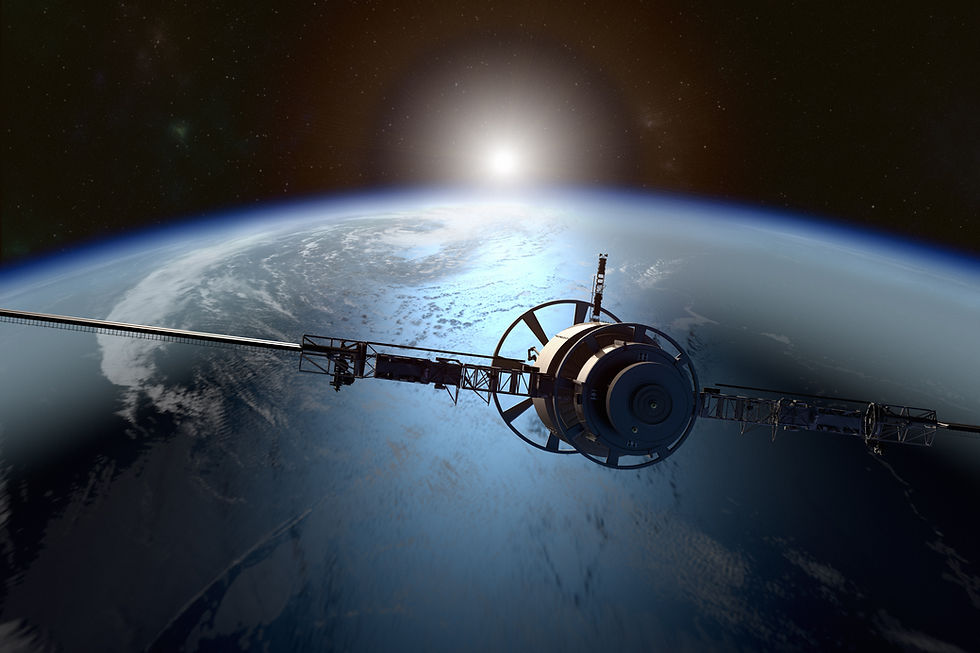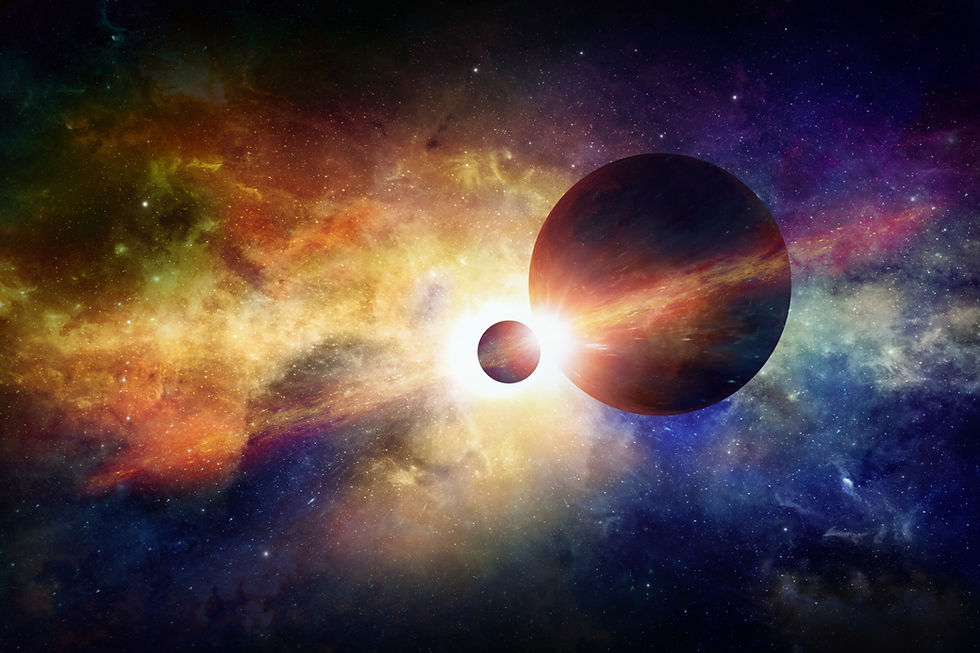Mars: Inside the Red Planet’s Secrets and Science
- Riyam Ojaimi

- Nov 9, 2024
- 5 min read
Updated: Nov 8, 2024
Mars, often called the “Red Planet,” has captivated scientists and dreamers alike for centuries. Its proximity to Earth and tantalisingly Earth-like characteristics have made it the subject of intense study and exploration. But Mars is much more than just another rocky planet. This enigmatic world offers a glimpse into the past of our own planet and, perhaps, a vision of humanity’s future beyond Earth.

Planetary Characteristics
Mars stands out in the solar system for its unique features and striking appearance. Named after the Roman god of war, Mars earns its nickname thanks to the reddish hue of its surface, a result of iron oxide or rust coating much of its soil.
Size and Orbit: Mars has a diameter of about 6,779 kilometers, roughly half that of Earth, giving it only about 10% of Earth’s mass. It orbits the Sun at an average distance of 228 million kilometers, taking 687 Earth days to complete one orbit - nearly twice as long as Earth’s year.
Gravity: Mars’ gravity is about 38% that of Earth, meaning a person who weighs 100 kilograms on Earth would weigh just 38 kilograms on Mars.
Climate and Seasons: Mars experiences seasons similar to Earth due to its tilted axis (25.2°), but the thinner atmosphere and greater distance from the Sun result in a harsher climate, with average temperatures around -80°F (-60°C). Temperatures can swing from -195°F (-125°C) at the poles in winter to up to 70°F (20°C) near the equator in summer.
History and Formation
Mars formed about 4.6 billion years ago, around the same time as the rest of the solar system, through a process called accretion, where dust and gas in the early solar system collided and clumped together.
Early Conditions: Mars likely had a more hospitable environment billions of years ago, with rivers, lakes, and possibly oceans. This period, known as the Noachian Era (around 4.1 to 3.7 billion years ago), was marked by significant volcanic activity, a thicker atmosphere, and abundant water.
Climate Evolution: Over time, Mars’ climate changed drastically. Around 3 billion years ago, during the Hesperian Period, it transitioned to a colder, drier state. Mars' magnetic field weakened, leaving its atmosphere vulnerable to solar wind and radiation, which stripped it away, turning Mars into the cold, arid planet we see today.

Composition and Surface Features
Mars has a rocky composition similar to Earth and other terrestrial planets but with a few unique characteristics that make it one of the most diverse landscapes in the solar system.
Soil and Minerals: Mars’ regolith, or surface soil, is rich in iron oxide, giving it its red color. The soil also contains minerals like silicates, sulfur, and even trace amounts of perchlorates, which can be toxic to humans.
Water: Evidence of ancient river valleys, lake beds, and polar ice caps suggests that Mars once had a significant amount of liquid water. Today, most water on Mars exists as ice, with polar ice caps made of both water and dry ice (frozen carbon dioxide). Seasonal changes cause CO₂ to sublimate in the summer, contributing to its tenuous atmosphere.
Volcanoes: Mars is home to Olympus Mons, the largest volcano in the solar system, standing 22 kilometers high and spanning 600 kilometers in diameter. This shield volcano dwarfs any on Earth and suggests Mars was volcanically active for a considerable part of its history.
Canyons and Valleys: The Valles Marineris canyon system is another of Mars’ remarkable features. Stretching over 4,000 kilometers and reaching depths of up to 7 kilometers, this canyon is one of the largest in the solar system.
Craters: Mars’ surface is dotted with impact craters from meteorite collisions, most notably the Hellas Planitia, a massive impact basin stretching over 2,000 kilometers in diameter. These craters tell a story of Mars’ interactions with other bodies in the solar system.

Mars’ Thin Atmosphere
Mars has a much thinner atmosphere than Earth, with an atmospheric pressure less than 1% of Earth’s at sea level. Composed mainly of carbon dioxide (95%), nitrogen (2.7%), and argon (1.6%), it lacks sufficient oxygen and pressure to support human life without artificial habitats.
Weather Patterns: Dust storms on Mars can envelop the entire planet, reducing visibility and affecting solar-powered missions. These storms, fuelled by the thin atmosphere and temperature fluctuations, can last for weeks or even months.
Exploration Missions: Past, Present, and Future
Mars has been the target of numerous robotic missions by NASA, ESA, and other space agencies. Each mission has advanced our understanding and brought us closer to the ultimate goal: human exploration.
Historic Missions: Mars exploration began with the Mariner and Viking missions in the 1960s and 70s, which provided the first close-up images and revealed surprising details about Mars’ surface and atmosphere. The Viking 1 mission also carried out the first biological experiments on Mars.
Rovers and Landers: More recent missions like Spirit, Opportunity, Curiosity, and Perseverance have revolutionised our knowledge of Mars. These rovers have explored Martian geology, climate, and signs of past microbial life. Perseverance, launched in 2020, is currently investigating an ancient river delta in Jezero Crater, where scientists hope to find preserved biosignatures in the rock.
Future Missions and Human Exploration: NASA’s Artemis Program aims to build a sustainable presence on the Moon as a stepping stone to Mars, with the goal of a human mission to Mars in the 2030s. Other private companies, notably SpaceX, are working on technologies to make Mars colonisation a reality.

The Jezero Crater
Why Mars? The Quest for Life Beyond Earth
Mars holds a special place in the search for extraterrestrial life. Its early history, once warmer and wetter, suggests it might have been habitable for microbial life. Martian meteorites found on Earth contain organic molecules, further fuelling speculation about ancient life. The discovery of recurring slope lineae (RSL) - dark streaks that appear seasonally on Martian slopes - suggests that briny liquid water might still occasionally flow on Mars today, making it a promising place to look for current life. If Mars ever supported life, even at the microbial level, it would profoundly impact our understanding of life’s potential across the cosmos.

The Future: A Martian Colony?
With NASA, ESA, SpaceX, and other organisations setting their sights on Mars, the prospect of a Martian colony seems closer than ever. Such a colony would face many challenges, but a human presence on Mars would provide a “planetary insurance policy” for humanity and allow for groundbreaking research that could benefit life on Earth.
Mars may be a hostile world, but its potential for exploration, discovery, and possibly habitation continues to inspire scientists, engineers, and dreamers alike. The Red Planet is more than just a distant, rocky neighbour - it's a gateway to the stars and perhaps, one day, humanity’s second home.
Yours truly,
Riyam Ojaimi




.png)
Σχόλια